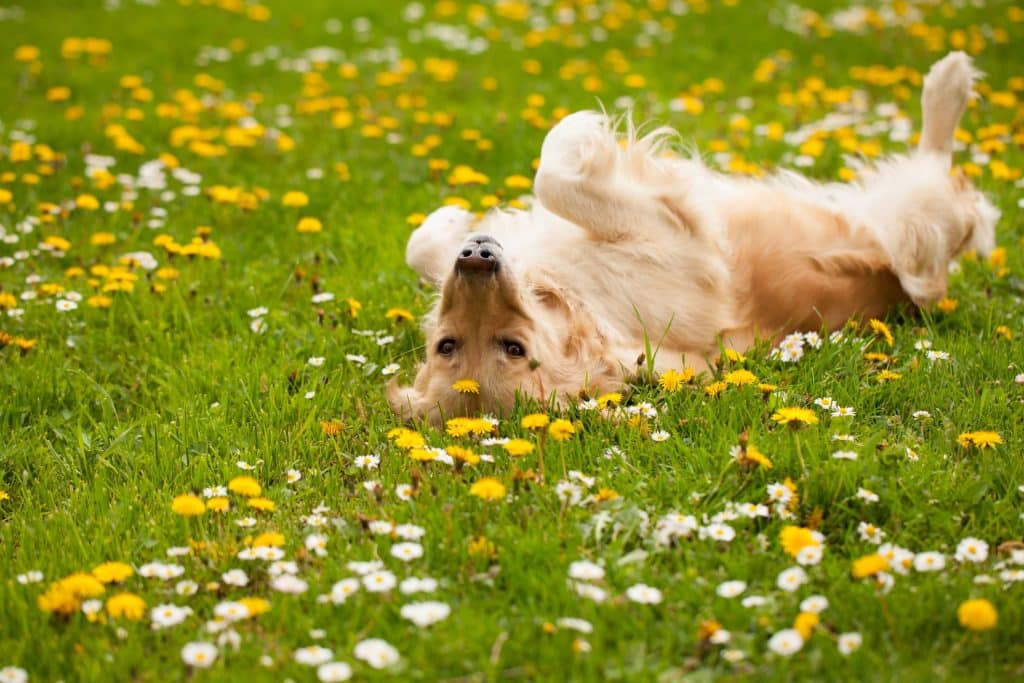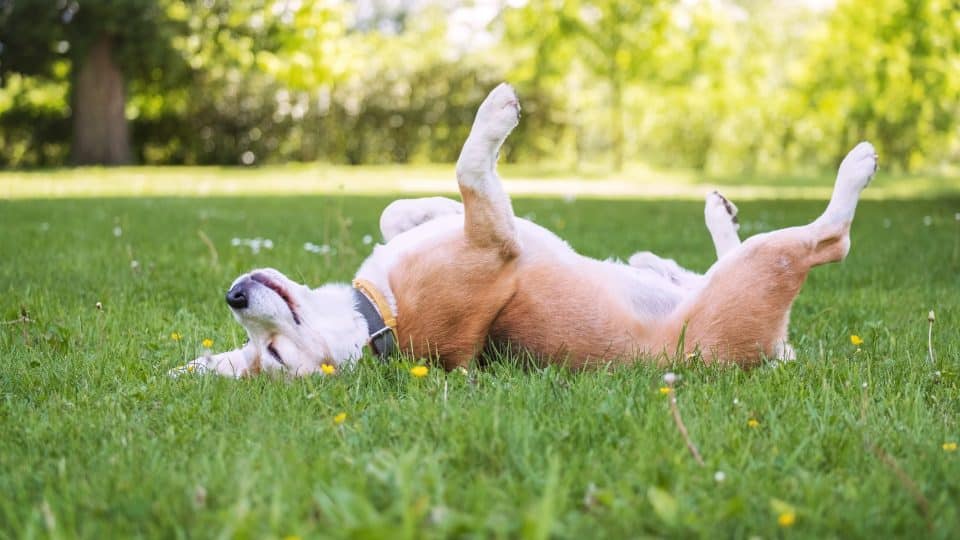- This article has been reviewed by a pet health professional. It is not a substitute for professional veterinary advice.
So your dog has done it again. They stopped, dropped, and rolled in the grass in a way that made you wonder what’s so special about the ground. Fortunately, unless your dog is actively looking for poop, you don’t need to worry about your dog rolling in the grass.
Rolling in the grass, also known as scent rolling, is normal behaviour for dogs and has multiple purposes. From communication to behavioural reasons, dogs like grass because it holds a lot of information about who has been there or what happened in the area.
At Rover, we don’t mind when our dogs roll in the grass because, for the most part, the loose body language signals that our dog feels comfortable and happy. But there can be medical reasons your dog rolls in grass — so it’s a good idea to figure out if this is new or old behaviour.
Read on to discover why dogs roll in the grass and what to do if you want to manage the behaviour.
Reasons Dogs Roll in the Grass
1. Feeling happy
Loose, wiggly body language is a key expression of dog joy. Dogs roll on their back when they feel happy, which can also signal trust and a desire to play. If you frequent a grassy field with your dog to play fetch, they may roll in the grass as a way to share how excited they are to play with you.
2. Communicating with other dogs
Some dogs may roll in the grass to add their scent to the location. This could be your dog sending a message about marking their territory or leaving a friendly hello to other dogs in the area.
If your dog frequently rolls around their bed or your furniture, then it’s more likely that their intention is to claim an area than to mask their own scent.
3. Like the feel of grass
Sometimes, the answer is simple: rolling in grass feels good to a dog.
“Those grass blades that tickle us can serve a function to our pets,” says Nicole Ellis, Los Angeles-based author and Certified Professional Dog Trainer. She points to examples such as removing loose fur or dirt and loosening stuck sap.
4. Scratching or soothing their skin
One of the simplest reasons dogs roll in the grass is because they’re itchy. Allergies or other skin irritations might cause irritation or discomfort, and the grass offers a way to scratch that itch.
“If you notice excessive scratching or redness, it’s wise to consult a veterinarian,” says David D’Angelo, an accredited pet nutritionist and veterinary support assistant.
5. Instinct to mask a scent
Rolling in grass or other strong-smelling things — mud, remnants of dead animals, trash — is a natural instinct. For hunting dogs, this behaviour may be a result of their prey drive. Dogs like hound and cur dogs are more likely to be masking their scent so their “prey” doesn’t smell them coming.
“[It] harks back to their wild ancestors who would roll in grass or other scents,” D’Angelo explains. Recent research shows that scent rolling happens more often when a wolf encounters an unfamiliar odour.
6. Getting rid of a scent
Ever notice your dog roll in the grass right after a bath? Dogs sometimes do this to get rid of unfamiliar scents (like shampoo) and replace them with something more natural. They also might be trying to dry off their coat faster, or could just be excited and get post-bath zoomies from being clean.
7. Cooling down
A dog who only rolls in grass during the summer or hot weather seasons may be trying to cool off. The soft, cool surface of grass may help your dog feel good on particularly warm or sunny days. “You might see them [rolling to] cool down as they enjoy the grass beneath them,” D’Angelo confirms.
8. Stretching
Rolling in the grass can also just be a way for dogs to stretch their muscles, especially after lying down or sitting for a while. For dogs who are just stretching, you’ll notice them roll in the grass more spontaneously.
The next time you suspect your dog will roll in the grass, watch their behaviour before and after the interaction. A dog sniffing the grass before rolling in it will carry a different meaning than a dog who rolls without looking twice.
Should You Stop a Dog from Rolling in Grass?
In general, seeing your dog roll in grass is a good sign that they trust you or are enjoying their outing with you. You don’t need to be concerned about this behaviour unless:
- Your dog has skin allergies: You can determine if your dog has a potential allergy by wiping your dog down after a grassy roll and seeing if it makes a difference in their scratching, says Ellis.
- Your dog seeks out poop or dead things: Sanitary concerns are absolutely a good reason to stop your dog from rolling in grass.
- You suspect compulsive behaviour: Some dogs can become obsessed with doing the same behaviour over and over. “If your dog appears overly obsessed with this behaviour or shows signs of discomfort, then it’s time to intervene,” says D’Angelo.
Speak to your vet about ways to reduce any anxiety or stress that could be leading to the obsessive behaviours.

iStock/rasevicdusan
How to Redirect a Dog Who Loves to Roll
Convenience is a valid reason to redirect this behaviour, especially if your dog loves to roll in the grass after a bath. The key to redirect your dog is to interrupt them before they roll and give your dog an alternative outlet such as chasing a toy or doing tricks.
Ellis recommends some training opportunities:
- Start by calling your dog by their name over to you to interrupt the behaviour.
- If they don’t have a strong recall, get treats. Call your dog again and reward them when they come.
- If there’s still resistance, put a lead on your dog, nicely lead them away, and immediately reward them for doing a trick like a sit or high five.
Knowing what alternative action to train your dog for will depend on your dog’s reason for rolling in the grass. For example, if your dog is interested in spreading their scent, you could give them the option to rub against you instead of the grass. If your dog is relieving an itch, call them over after they sniff and give them a good, targeted scratch.
At the end of the day, if your dog is rolling in the grass and there are no major medical concerns, there is no harm in letting them have fun. Rolling in grass is a beautiful way a dog communicates how happy and secure they feel with you.
To better understand why your dog rolls in the grass, read up on dog body language for context clues.



